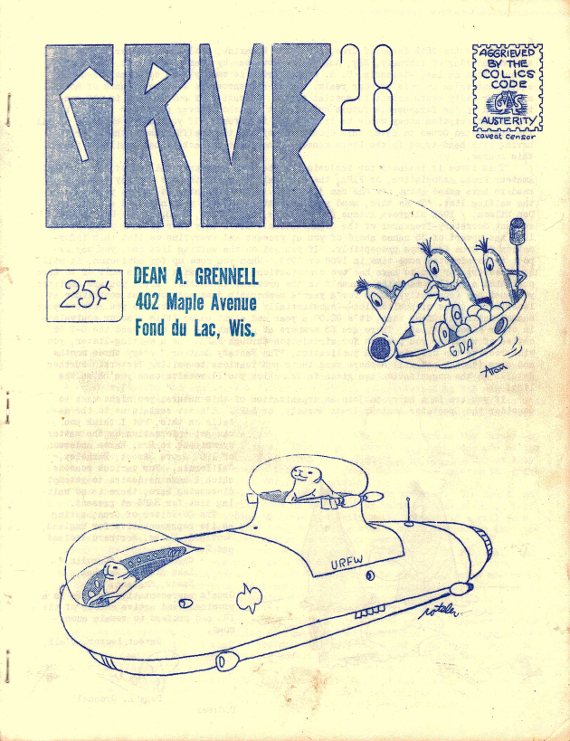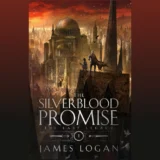
Fanzines reviewed: GRUE (#29 & 28), published 1956/1958.
About forty years ago Harry Warner Jr. described Grennell as “the forgotten fan.” Yet only twenty-five years earlier (in the early fifties) he’d been widely respected and renowned among fans worldwide. With his sense of humour and innovative publishing techniques, Grennell, who lived in Fond du Lac, Wisconsin, splashed into fandom big time circa 1952/53 with eccentric early issues of “Grue” featuring drawings hand drawn on each copy (much as Nils Helmer Frome did back in the 1930s with his Supermundane Stories). One issue even featured an oil paint cover individually painted for as many copies of the issue he produced. Not till the 15th issue did he begin publishing “normal issues.” By the late fifties his frequency of publication slowed down to once a year, then to every couple of years, then finally ceased as he moved on to other interests outside fandom.
Yet there are old-time fen who remember him still for a number of creative contributions to fandom. For instance, writing under the name “Art Wesley,” he co-edited, with Canadian Norman G. Browne (founder of the Vancouver SF Society “The Hibited Men” & Editor of “Vanations”), a unique publication titled “Filler” which contained nothing but interlineations, those catchy phrases often used to separate articles, each one individually numbered. The idea, once Filler had been distributed and everyone in fandom possessed a copy (in theory), was for faneds to print just the number, thus forcing every reader to look up the appropriate interlineation in “Filler.” A tongue-in-cheek bit of whimsy.
Many of the sayings listed in Filler were quotes. Some were original to the editors. One that Grennell came up with was “But, if you didn’t like crottled greeps, why did you order them?”
“Crottles,” as he later explained, was the technical name for the tiny bubbles drawn around the heads of drunken characters in newspaper comics, but “greeps” was a word he plucked from the ether. “Crottled greeps” being, therefore, some sort of disgusting, discombobulating and very disturbing food. Most fans assumed it would be green in colour. For decades fans competed in creating barely edible foodstuffs that were supposedly the genuine article. I, myself, have eaten crottled greeps, or what was purported to be crottled greeps. To this day I have no idea what it consisted of, except that it was sour, salty and sweet all at the same time. And green. Of course it was green.
Turning now to “Grue,” you might suspect it derives from “gruel,” or “gruesome.” Grennell originally claimed he took the word from an advertisement for “Other Worlds,” one of the lesser known prozines of the day. Eventually the story grew in the telling and he insisted he’d derived the line from a novel by E.E. “Doc” Smith which allegedly read “the cold grue of a thousand fiendishly eaten ancestors.”
The two issues here reviewed are part of the George Metzger donation to the BCSFA archive. They were published in the later, more sedate stages of Grennell’s fannish career.

Grue (#28) – May 1956
Faned: Dean A. Grennell. American Genzine.
The first article, by Dave Jenrette, details a visit to Cross Plains, Texas, where Robert E. Howard, creator of Conan the Barbarian, lived nearby on the family ranch till his suicide. Dave meets Mr. S. Foster Bond, the town mayor, who knew Howard and his father quite well.
“The Mayor spoke of Howard’s complete detachment from the world of Cross Plains and how he kept to himself. In his younger days Howard had been over often for a glass of milk or such, but as he grew older his contacts with the town were less and less.”
Dave also runs into Lindsey Tyson, who was Howard’s roommate at Howard Payne University. Lindsey recalled Howard gleefully receiving a $24 check as payment for the first short story he managed to sell, namely “Spear and Fang” which was subsequently published in the August 1925 “Weird Tales” magazine. Tyson also stated that Howard preferred writing poetry, but found it harder to sell then his prose. He claimed that “a good deal of this verse” was in the University library. One hopes researchers have since examined every line, especially any poems never published. Robert E. Howard “The Poet.” Not how I envisioned him.
This issue of “Grue” was included in a FAPA (oldest SF Amateur Press Association) mailing, and the second article is by Robert Bloch (of “Psycho” fame) commenting on the previous mailing’s contributions. Of particular interest he writes “Helen, I was much interested in your mention of that Japanese Sex Worship Museum. Maybe FAPA could take up a collection so that when Les Croutch dies we can have him stuffed and donated to the place. On second thought, why wait? Let’s do it now!”
Leslie A. Croutch was a very prominent Canadian fan in the forties and fifties and a member of FAPA. He was noted for his distaste for censors and prudes, not to mention the vice laws of the day, and tended to go on and on at length railing against prudery. Seems Bloch was a bit tired of this.
Speaking of sex, in an article nattering about this and that, British fan Chuck Harris comments “I see that somebody was suing a Marilyn Monroe calendar company for not paying him for the stick-on panties and bras that he invented so that those calendars could be sent through the US mails. It seems almost a Rotsler invention…”
To this Grennell adds “I wonder, sometimes, if it’s possible for two fans to discuss sex without bringing Rotsler into the conversation.”
Rotsler was an incredibly prolific illo artist for any Faned who wanted to print his simple but evocative doodlings. He even sent ME some, and I was (and probably still am now that I think about it) a comparative unknown. But he was also noted for his prolific production of pornographic films. Indeed, the BCSFA archive contains a Christmas card he originally sent to Susan Wood, featuring a photo of himself surrounded by naked women with the caption “wish you were here.” Seems he was quite enthusiastic about everything he did. The prestigious annual Rotsler Award for best fan artist is, of course, dedicated to his memory.
Also in this issue an article by the up and coming fan John Berry (inventor and chronicler of “The Goon Defective Agency) about fellow Irish fan George Charters. It includes an “epic” poem written by Charters describing a “Ghoodminton” contest in the Walt Willis home, the famous “Oblique House,” in Belfast, Northern Ireland. Walt Willis and John Berry team up against Robert Shaw and James white (the latter two famous fans like Willis and Berry, but soon to become popular SF novelists as well).
I’ve never been clear on the setting for Ghoodminton. I know a net was stretched between a printing press and a chair, and that the belly button of Marilyn Monroe (as featured on a calendar hanging on the wall) formed one of the boundaries of the court. “Bats” were squares of cardboard used to batter a “molting shuttlecock” about. Allegedly the game was played with extreme violence, in as much the players frequently collided with the walls, the ceiling, the spectators, each other, and often the floor. Scrapes and bruises were common. The following sample excerpts from the poem give some idea of how Ghoodminton was played.
“To his side there sprang John Berry,
Vigorous, alert John Berry,
Shouting out his fierce war-cries,
Till the walls and ceiling trembled,
Till the floors and windows rattled,
With the noise reverberating
Round the Willis fambly attic.”
And
“How to tell of that grim conflict,
How they battled, how they struggled,
Flashing eyes and heaving bodies,
Shouting ‘face’ and screaming ‘ceiling,’
Till the neigbours must have thought there
Were some murders being committed.”
Eventually scrabble games replaced Ghoodminton at Oblique house. Marginally safer, you see.
Grennell himself contributes a long, rambling article on various topics. He tells of having checked out the back files of the Fond du Lac Commonwealth Reporter, the local newspaper, one printed on the day of his first birthday, I think in the early twenties. Back then horoscopes were a bit more specific than nowadays.
“Scorpio governs the genital organs of the Grand Man. These people are allied to the great powers of the oceans of this planet, and are possessed of a wonderful vibratory force… Those born under this sign are usually robust, and inclined to corpulence in middle life. They have dusky complexions, broad square faces and dark hair.”
This must have left skinny, pale-faced blond Scorpios fairly confused. Born on the cusp perhaps.
The newspaper also contained a full page detailing the technological wonders of the near future: “Crewless ships and air dirigibles will carry use safely across seas and through the air guided by an ‘invisible pilot’… Human ills reduced by physical and chemical effects of radio frequency currents applied in long distance treatment. Thought waves transmitted from brain to brain around the world by mental radio.”
Hmm, seems much was expected of radio back then.
Speaking of dirigibles, Grennell actually witnessed the Graf Zeppelin flying over Kansas circa 1929. It was crossing America as part of its voyage circling the entire planet. As he put it “It looked impressive as it floated along the horizon a mile or two away.”
Much other good stuff I’ll skip over and move on to the next issue.

Grue (#28) – May 1956
Faned: Dean A. Grennell. American Genzine.
Bob Tucker (a very famous fan as I’ve mentioned dozens of times in previous columns) leads off with an article by his alter-ego Hoy Ping Pong, describing the script of a movie to be based on a novel Tucker had written, “Wild Talent,” published in 1954, and allegedly to be filmed by Sol Lesser Productions under the title “The Man From Tomorrow.” However, I doubt Hoy Ping Pong’s version of the script is anything other than a spoof of Hollywood SF films in general, as the following excerpt indicates:
“The camera reveals a close-up of our hero standing before the spaceship. He is fearless and unafraid, reading the green minds of the monsters within. Slowly, he brings from his pocket the precious bag of marbles and offers it as a symbol of peace.”
“I am the man from tomorrow! And I order you to return to your home star, never to visit this world again.”
“The monster cringes at his words and the dreadful power of his mind. Backing awkwardly, it shambles into the ship and issues orders to take-off. Fire bellows from the stern tubes and the flying saucer shoots up into the sky. All over the world, other saucers are doing likewise. Our hero waits until they are safely in space and then twists his super-Esper Powers to the utmost. His eyes bulge and sweat runs down his face. He stares into space.”
“In the distant ship, the marbles suddenly spew from the bag and fly about the control cabin. Like stinging insects they dart here and there, hitting control keys, spanging delicate mechanisms, destroying the nerve centre of the ship! The saucers wheel crazily, turns and plunges into the sun. The monsters have been vanquished.”
Sounds like it would make a fun movie, better than some of the dull crud we’ve seen recently.
Wrai Ballard contributes an article about, of all things, Hopalong Cassidy. Now I remember that TV Western. My brother even saw the actor in character riding a horse at a personal appearance in Ottawa. Hopalong was okay, but nothing great I thought.
According to Ballard the Hopalong Cassidy in the original books was a “real man” much given to not bothering to wash himself or his clothes, who was addicted to tobacco, and a proud killer of plenty of guys who deserved to die. The TV Hopalong on the other hand…
“Nauseating, isn’t he? A neatly dressed fellow wearing two fancy guns. Never swears, drinks, or chews tobacco… he is even polite to the villain… To this Hopalong… hell, I can’t disgrace a good name that way, I’ll call him Flouncealong… a gun is something you wave around and fire at random until you get close enough to the villain to beat him up in a fist fight…”
Aha! I do believe Ballard has pointed out the flaws in Hopalong’s character which failed to impress me as a little kid. Hoppy was too much of a do-gooder, his show like something written by my mother. Couldn’t hold a candle up to Paladin in “Have Gun Will Travel.” My original impression vindicated!
Next, in what appears to be an ongoing series in which Irish fans write about each other, Bob Shaw reveals much about John Berry, including his tactics when playing Ghoodminton.
“In spite of the fact he is the most energetic member of Irish fandom John prefers to win his games by craft and stealth. His favourite ploy is based on the “Galaxy” [Magazine] story about the natives whose method of war was to dash up to the enemy and cut their own throats. When you serve or return the shuttlecock to John he shouts unintelligible phrases at the top of his voice, bounds into the air, collides with something and skins his elbow, lands flat on his back, hits his head on the floor, trips his partner, scrabbles for the shuttlecock, loses his bat, heads the shuttlecock back across the net and looks at you trustingly. If you hit it back you know he will start the whole performance over again. After a while you just let the shuttlecock fall at your feet. It’s easier.”
Sometimes John tries a new tactic. “He is always inventing new kinds of bats. Once he turned up with one which had a photo of Marilyn Monroe on it. John held it in opponent’s faces at crucial moments but he lost more points than he gained. He kept falling into trances at the wrong times, and several times he lost points because his eyeballs were bulging into the wrong court.”
This the effect Marilyn Monroe had on Irish fandom. Incredible as it may seem to today’s callow youth, she really was THE sex goddess of the era. She had no rivals. None. I remember.
Dick Ellington, who invented the fannish term FIJAGH writes about his plans to unveil it to the world at large, and also about the reaction from those he’d given a sneak peak.
“Have also had to shelve the projected firstish of FIJAGH (guess the title and win a free box of Guava Jelly) tho actually did get a good part of it dummied… Bloch is still puzzled over the derivation of FIJAGH. Larry T. Shaw, boy genius, guessed it after about five minutes… Pat Scott, Girl Luvverly Fan, in about three weeks, but nobody else has at all.”
And of course we all know FIJAGH stands for “Fandom Is Just A Goddamned Hobby.”
There’s also a fascinating article where Fred Chappell attacks the shoddy quality of Sam Moskowitz’s 1930s history of fandom, “The Immortal Storm.” I think I’ll wait till I review that book before quoting Chappell’s incendiary comments.
So, a brief glimpse of two issues of “Grue,” famed in its day for the number of “Big Name Fans” who contributed on a regular basis. In my opinion, a fascinating look at the fannish sensibilities of more than half a century ago.
BY THE WAY:
You can find a fantastic collection of zines at: Efanzines
You can find yet more zines at: Fanac Fan History Project
You can find a quite good selection of Canadian zines at: Canadian SF Fanzine Archive
And check out my brand new website devoted to my OBIR Magazine, which is entirely devoted to reviews of Canadian Speculative Fiction. Found at OBIR Magazine










